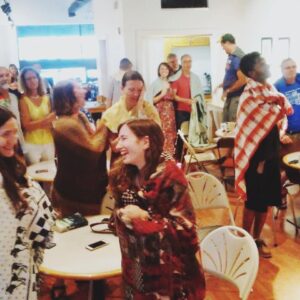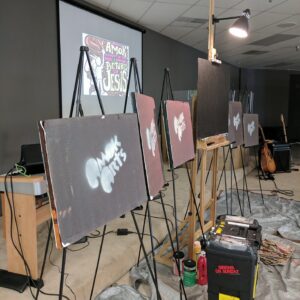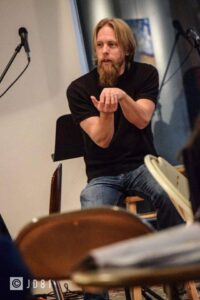In 1708 the original eight members of what would become the Church of the Brethren started
something new as they entered the waters of the Eder River for their baptism. Though it was
indeed a new church they began, it was not without historical antecedents. The Church of the
Brethren emerged from the influence of Radical Pietism that Alexander Mack’s mentors
exemplified and espoused. They withdrew from established state churches to study the Bible
on their own in small groups. They believed that the lives of Christians needed to reflect the
holiness of God. Pietists also emphasized a personal, spiritual relationship with Jesus.
As the founders of the Church of the Brethren met in their small group studying the Scriptures,
they eventually became convicted that the Radical Pietists, for all their helpful reforms, had
missed something important in their rejection of the organized church. Especially in Matthew’s
Gospel, they saw a mandate for Christians to be in a visible congregation. Anabaptist writings
and ideas helped persuade Mack and the others that their impulse to form a new church had
merit.
The early Brethren spread their faith with zeal and joy, despite the persecutions and the other
hardships following their convictions entailed. As the church grew, so did the need for more
leaders and more congregations. As the future Church of the Brethren moved to America and
continued its growth, even more churches were formed. Annual Conference began in order to
ensure all these different congregations would still form one larger body of faith, holding to
similar theological convictions.
As the Church of the Brethren continues to plant new congregations, it is helpful to know what
distinguishes Brethren churches from other denominations and non-denominational new church
starts. In a world where denominations are largely in decline and even non-denominational
mega-churches may be past their hay-day, many Christians are worshiping in churches without
much regard for the denominational roots that gave rise to them.
We do not claim that the Church of the Brethren is the “best” denomination and we know that all
Christians form the universal body of Christ, we do believe that the Church of the Brethren is
well-suited to reach this generation with the Gospel of Jesus. At our best, the expression of our
faith entrusted to us by our forerunners is powerfully attractive, especially to today’s young
adults. Our emphasis on doing what Jesus did, including the experiential aspects of our
worship (love feast, foot washing, believer’s baptism, etc.) combined with the service and
volunteer work for which the Brethren are known are very compelling for seekers looking for a
vital spiritual connection with God.
Therefore, we thought it would be useful to explore what it is that makes a church plant uniquely
Brethren…
(with thanks to our Mennonite Brethren sisters and brothers for this helpful resource…12
Principles of Anabaptism)




A uniquely Brethren church plant would have a high view of the Bible. The Scriptures would be
authoritative in their life together and would be collectively discerned through the Spirit. One
way to live this value out would be to have a more dialogical approach to the preaching of the
Bible.
A uniquely Brethren church plant would emphasize the New Testament, after all the Church of
the Brethren states the New Testament is our creed. This doesn’t mean that the Old Testament
isn’t important, just that we read the Old through the perspective of the New.
A uniquely Brethren church plant would emphasize Jesus as central to all else. Jesus is our
example, teacher, master, and Lord as well as Savior. He isn’t just the Secretary of After Life
Affairs, he is concerned with all of life.
The necessity of a believer’s church would characterize a uniquely Brethren church plant. One
of the ways a church plant can live into this value is by adult baptism. One church plant throws
a party for each baptism that they hold, as a means of celebrating someone making a decision
to follow Jesus and cementing that decision through Christian baptism.
Discipleship and following in the way of Jesus would be a primary component of a uniquely
Brethren church plant. We are not only to worship Jesus, we are to follow Him. Dallas Willard
asks, “Does your church have a plan for discipleship and is it working?” One church plant has a
plan based around 5 contexts (see Discipleship that Fits by Alex Absalom & Bobby Harrington
for more information).
A uniquely Brethren church plant would insist on a church without class or divisions. In a deeply
polarized world, a church that could love each other in the midst of differences (political,
theological, social, etc..) would point to the love of Christ in their midst and to the in-breaking of
the Kingdom of God.
A uniquely Brethren church plant would challenge the individualism of our day, by calling people
into the covenant community. “An individualistic or self-centered Anabaptist is a contradiction in
terms.” In one community, this looks like each regular attender having a deacon who keeps in
contact with them regularly.
A uniquely Brethren church plant would live as a visible counter-cultural community. The values
of the community would be drawn from the upside-down Kingdom of God and not primarily
through the values of the Kingdom of the world. One way to live into this reality is to live a third-way
that doesn’t fall into the dominant narratives and polarity of our day.
Peace as a holistic lifestyle derived from the Prince of Peace would be part of a uniquely
Brethren church plant. “Anabaptists believe that the peace position is not optional, not marginal,
and not related mainly to the military. On the basis of Scripture, Anabaptists renounce violence
in human relationships. We see peace and reconciliation – the way of love – as being at the heart
of the Christian gospel.”
Servanthood would characterize a uniquely Brethren church plant. This type of community
would take seriously Jesus’ call to live a life of service. One community, as a means of entering
into service as a community, offers a 5th Sunday Day of Service where instead of gathering to
worship, they gather to serve their local community.
And lastly, a uniquely Brethren church plant would be a missional community. They would see
themselves as a community on mission- a mission to “make disciples of all people, baptizing
them, and teaching them to obey and follow Jesus.”
We strive in the Church of the Brethren to continue “the work of Jesus; peacefully, simply,
together.” What we have shared in this article is done with the hope that new expressions of the
CoB will find support and encouragement to join in that work! The world needs the Brethren to
share the Good News!





Ryan Braught is the Pastor/Church Planter of Veritas. Along with his wife and kids he founded Veritas in 2009. He is the husband of Kim, and father to Kaiden and Trinity. Ryan has a BS in Telecommunications from Kutztown University and a Master of Arts in Religion from Evangelical Theological Seminary. Besides his work with Veritas, Ryan loves to read, listen to music, snowboard, and spend time with his family.

Pastor Nate Polzin has been in ministry for over 20 years. In 1996, after graduating from Central Michigan University with a B.S. in Political Science, he was called by New Life Christian Fellowship in Mt. Pleasant, MI, to begin a campus ministry at Central Michigan University. That ministry, called Standing in the Gap, was blessed by God and continued to grow for many years. Eventually, Nate moved to Richmond, IN to finish his Master of Divinity degree at Bethany Theological Seminary. While he was there, he pastored the White Branch Church of the Brethren in Hagerstown, IN. He graduated from Bethany in May of 2007. He then moved to Saginaw to plant the Church in Drive and start a new Standing in the Gap chapter at Saginaw Valley State University. Nate is originally from Hemlock, MI and has lots of family in the Saginaw area. He married his wife, Mandy, in the fall of 2009. They have two children, Lucas and Michael. Nate is dually yoked with the Midland CoB.

